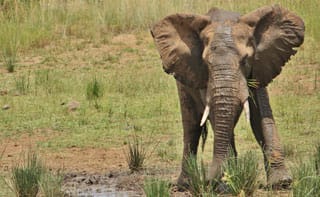Elephants in Pilanesberg

Characteristics
Male specimens have a shoulder height of up to 4 metres and can weigh as much as 5 tons. Groups are organized around the matriarch, an old female in the group. The matriarch leads a group of females and juveniles, which are all closely related to her. Male elephants leave the group after puberty and live alone or form smaller groups with other males.
The African elephant can be distinguished from its Asian relative by its larger ears and bigger body. African elephants live throughout Southern, East and Central Africa where they can find enough water and food.
Behaviour
Elephants forage by using their trunk to pull leaves and stems off trees and bushes. Less than half the food an elephant eats is properly digested and so African elephants eat about half a ton of plant material every day. The greenery is washed down with about 65 litres of water, which is why sightings are particularly frequent around waterholes and rivers.
